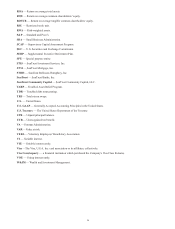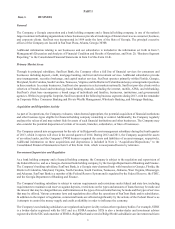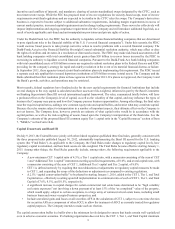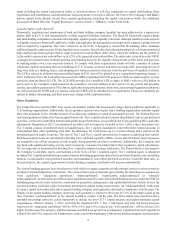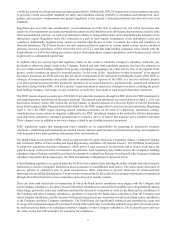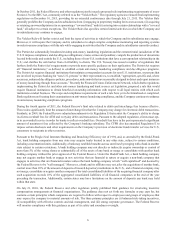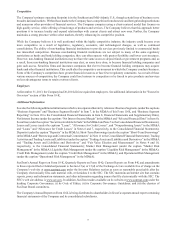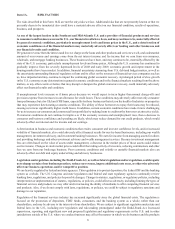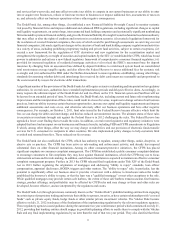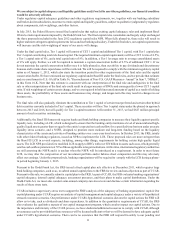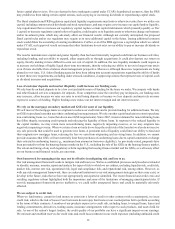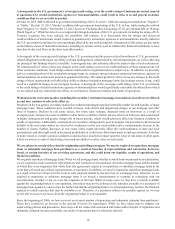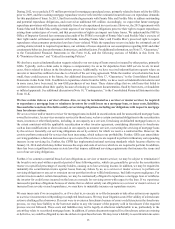SunTrust 2013 Annual Report Download - page 24
Download and view the complete annual report
Please find page 24 of the 2013 SunTrust annual report below. You can navigate through the pages in the report by either clicking on the pages listed below, or by using the keyword search tool below to find specific information within the annual report.8
Item 1A. RISK FACTORS
The risks described in this Form 10-K are not the only risks we face. Additional risks that are not presently known or that we
presently deem to be immaterial also could have a material adverse effect on our financial condition, results of operations,
business, and prospects.
As one of the largest lenders in the Southeast and Mid-Atlantic U.S. and a provider of financial products and services
to consumers and businesses across the U.S., our financial results have been, and may continue to be, materially affected
by general economic conditions, particularly unemployment levels and home prices in the U.S., and a deterioration of
economic conditions or of the financial markets may materially adversely affect our lending and other businesses and
our financial results and condition.
We generate revenue from the interest and fees we charge on the loans and other products and services we sell, and a substantial
amount of our revenue and earnings come from the net interest income and fee income that we earn from our consumer,
wholesale, and mortgage banking businesses. These businesses have been, and may continue to be, materially affected by the
state of the U.S. economy, particularly unemployment levels and home prices. Although the U.S. economy has continued to
gradually improve from the severely depressed levels of 2008 and early 2009, economic growth and improvement in the
housing market have been modest. In addition, financial uncertainty stemming from U.S. debt and budget matters, as well as
the uncertainty surrounding financial regulatory reform and its effect on the revenues of financial services companies such as
us, have impacted and may continue to impact the continuing global economic recovery. A prolonged period of slow growth
in the U.S. economy or any deterioration in general economic conditions and/or the financial markets resulting from the above
matters, or any other events or factors that may disrupt or dampen the global economic recovery, could materially adversely
affect our financial results and condition.
If unemployment levels increase or if home prices decrease we would expect to incur higher than normal charge-offs and
provision expense from increases in our allowance for credit losses. These conditions may adversely affect not only consumer
loan performance but also C&I and CRE loans, especially for those businesses that rely on the health of industries or properties
that may experience deteriorating economic conditions. The ability of these borrowers to repay their loans may be reduced,
causing us to incur significantly higher credit losses. In addition, current economic conditions have made it more challenging
for us to increase our consumer and commercial loan portfolios by making loans to creditworthy borrowers at attractive yields.
If economic conditions do not continue to improve or if the economy worsens and unemployment rises, then a decrease in
consumer and business confidence and spending are likely, which may reduce demand for our credit products, which would
adversely affect our interest and fee income and our earnings.
A deterioration in business and economic conditions that erodes consumer and investor confidence levels, and/or increased
volatility of financial markets, also could adversely affect financial results for our fee-based businesses, including our wealth
management, investment advisory, and investment banking businesses. We earn fee income from managing assets for others
and providing brokerage and other investment advisory and wealth management services. Because investment management
fees are often based on the value of assets under management, a decrease in the market prices of those assets could reduce
our fee income. Changes in stock market prices could affect the trading activity of investors, reducing commissions and other
fees we earn from our brokerage business. Poor economic conditions and volatile or unstable financial markets also can
adversely affect our debt and equity underwriting and advisory businesses.
Legislation and regulation, including the Dodd-Frank Act, as well as future legislation and/or regulation, could require
us to change certain of our business practices, reduce our revenue, impose additional costs on us, or otherwise adversely
affect our business operations and/or competitive position.
We are heavily regulated by federal and state agencies. This regulation is to protect depositors, the federal DIF and the banking
system as a whole. The U.S. Congress and state legislatures and federal and state regulatory agencies continually review
banking laws, regulations, and policies for possible changes. Changes to statutes, regulations, or regulatory policies, including
interpretation or implementation of statutes, regulations, or policies, could affect us adversely, including limiting the types of
financial services and products we may offer and/or increasing the ability of nonbanks to offer competing financial services
and products. Also, if we do not comply with laws, regulations, or policies, we could be subject to regulatory sanctions and
damage to our reputation.
Regulation of the financial services industry has increased significantly since the global financial crisis. The regulation is
focused on the protection of depositors, FDIC funds, consumers, and the banking system as a whole, rather than our
shareholders, and may be adverse to the interests of our shareholders. We are subject to significant regulation under state and
federal laws in the U.S., including new legislation and rule-making promulgated under the Dodd-Frank Act. Increased
supervision, reporting, and significant new and proposed legislation and regulatory requirements in the U.S. and in other
jurisdictions outside of the U.S. where we conduct business may affect the manner in which we do business and the products




